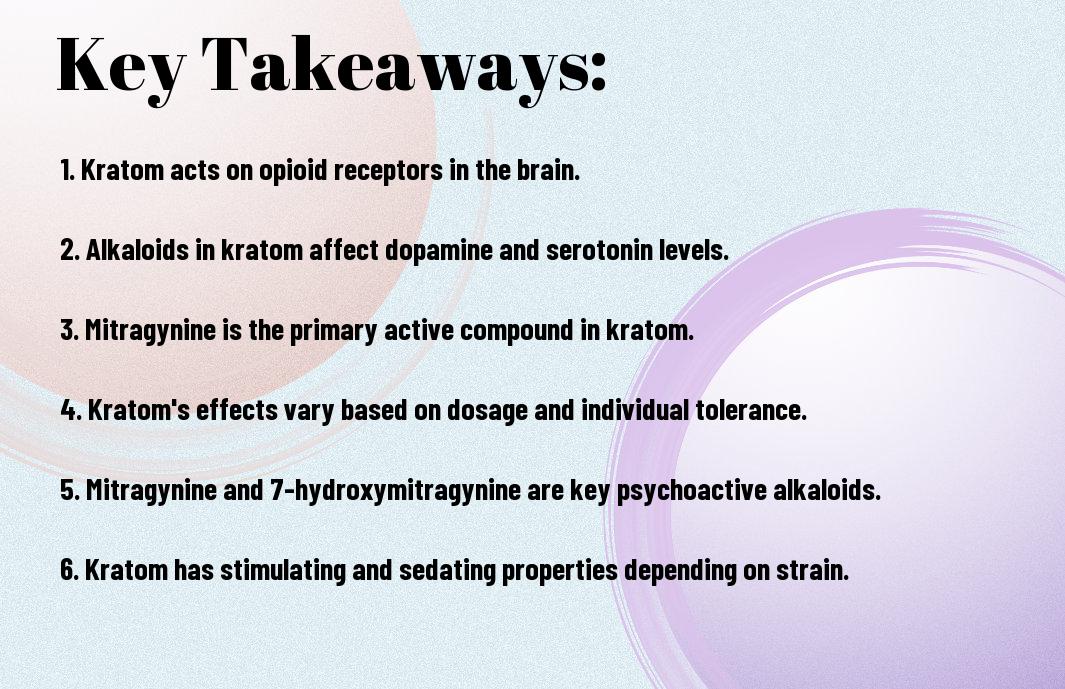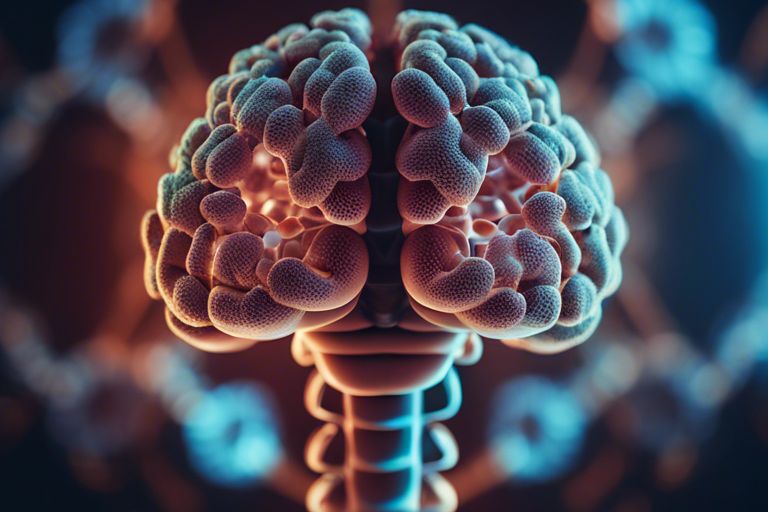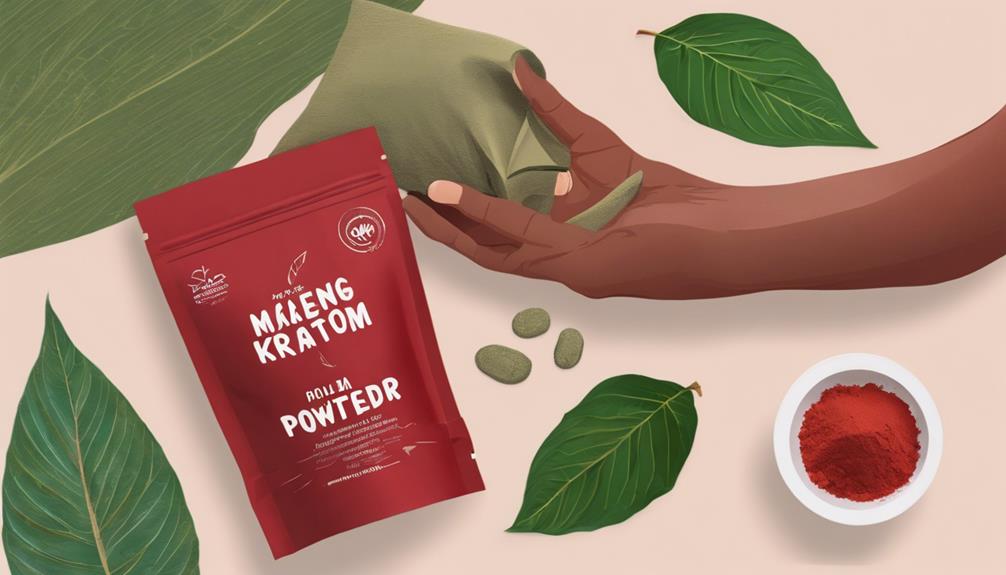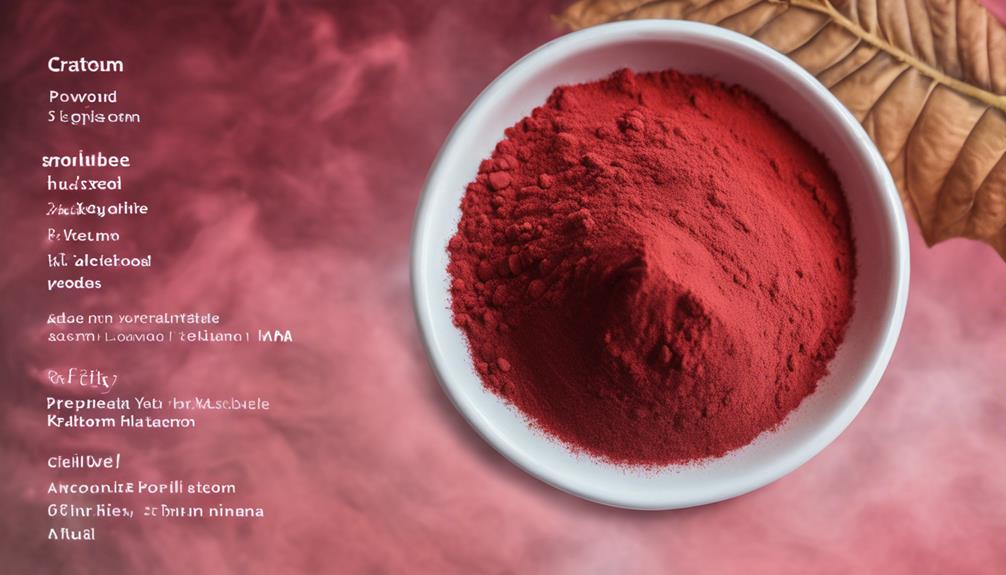With its potent effects on the body, understanding the mechanism of action of kratom is crucial. This article examines into the scientific details of how kratom interacts with the body to produce its effects, shedding light on its potentially beneficial and dangerous properties.
Key Takeaways:
- Mitragynine and 7-hydroxymitragynine: Kratom’s main active components, mitragynine and 7-hydroxymitragynine, bind to opioid receptors in the brain, producing pain relief and sedation similar to opioids.
- Stimulation of adrenergic and serotonergic systems: Kratom also affects adrenergic and serotonergic pathways in the brain, contributing to its stimulating and antidepressant effects.
- Complex mechanism: Kratom’s mechanism of action is complex and involves multiple neurotransmitter systems, highlighting its potential for both beneficial and detrimental effects on the body.

Kratom’s Chemical Composition
Alkaloids: The Primary Active Compounds
For a plant to exhibit pharmacological effects, it must contain bioactive compounds. In the case of kratom, the primary active compounds are alkaloids. Alkaloids are naturally occurring organic compounds that often have pronounced physiological effects on humans. In kratom, the most abundant alkaloids responsible for its effects are mitragynine and 7-hydroxymitragynine.
Opioid Receptor Binding
Active alkaloids present in kratom interact with various receptors in the brain, with a notable affinity for opioid receptors. These receptors are crucial in mediating pain perception, mood, and addictive behaviors. Opioid receptor binding by kratom alkaloids can lead to analgesic effects, feelings of euphoria, and potentially addictive properties.
The alkaloids in kratom bind to mu-opioid receptors in a selective manner, differentiating their mechanism from traditional opioid drugs. The unique interaction of kratom alkaloids with opioid receptors may explain the distinct effects reported by users, including pain relief without respiratory depression.
The Opioid System and Kratom
Assuming Drug Fact Sheet: Kratom, the mechanism of action of kratom involves its interactions with the opioid system in the human body. Kratom contains active compounds that target the same receptors as opioids, albeit with differing potencies and properties.
Mu-Opioid Receptors: The Primary Target
The mu-opioid receptors are the primary target of kratom’s active compounds. These receptors are involved in pain sensation, reward processes, and respiratory depression. By interacting with mu-opioid receptors, kratom can produce analgesic effects and feelings of euphoria. However, prolonged activation of these receptors can lead to tolerance, dependence, and respiratory issues.
Delta-Opioid Receptors: A Secondary Role
On the other hand, kratom also interacts with delta-opioid receptors in the body, albeit to a lesser extent compared to mu-opioid receptors. These receptors play a role in modulating mood, emotional responses, and cognitive functions. While the exact impact of kratom’s interaction with delta-opioid receptors is still being studied, it is believed to contribute to the overall effects of kratom consumption on a user’s well-being.
Further research is needed to fully understand the implications of kratom’s interactions with mu-opioid and delta-opioid receptors, especially in the context of its potential therapeutic benefits and risks.
Pain Relief Mechanisms
Opioid Receptor Activation
Notably, kratom’s pain-relieving effects are partially attributed to its ability to activate opioid receptors in the brain. These receptors are involved in regulating pain perception, and when activated, they can help reduce the sensation of pain throughout the body.
Inhibition of Pain Transmission
An additional mechanism through which kratom provides pain relief is by inhibiting the transmission of pain signals in the spinal cord. By blocking the pathways that allow pain signals to travel to the brain, kratom can effectively reduce the intensity of pain experienced by individuals.
For instance, kratom’s alkaloids have been shown to interact with neurotransmitter systems involved in pain regulation, such as serotonin and dopamine. These interactions can further enhance kratom’s analgesic effects and provide relief for individuals suffering from various types of pain.

Stimulation and Sedation
Now, let’s explore into the intricate world of kratom’s mechanism of action, particularly its ability to induce both stimulation and sedation in users. These effects are mediated through the plant’s interaction with various neurotransmitter systems in the brain.
Adrenergic and Dopaminergic Systems
Stimulation: Kratom acts on the adrenergic and dopaminergic systems, leading to increased alertness, focus, and energy. By stimulating these pathways, kratom can produce effects similar to those of stimulant drugs, offering users a boost in cognitive and physical performance.
The Role of 7-Hydroxymitragynine
Sedation: On the flip side, kratom can also induce sedative effects through its interaction with the opioid receptors in the brain. Specifically, the alkaloid 7-hydroxymitragynine plays a crucial role in promoting sedation and relaxation in users. This compound has been shown to have potent analgesic properties, making it a key player in kratom’s pain-relieving effects.
Hydroxymitragynine: While 7-hydroxymitragynine contributes to kratom’s sedative effects, it is vital to note that this compound also poses a potential risk for respiratory depression at high doses. Users should exercise caution and adhere to recommended dosages to avoid adverse reactions.
Kratom’s Effects on Mood and Anxiety
Once again, we examine into the intricate mechanisms by which kratom exerts its effects on mood and anxiety. The plant’s compounds interact with various neurotransmitter systems in the brain, leading to a diverse range of outcomes.
Serotonin and Dopamine Regulation
One way kratom impacts mood and anxiety is through the regulation of serotonin and dopamine levels in the brain. These neurotransmitters play crucial roles in mood regulation, and kratom has been found to modulate their release and reuptake in certain brain regions. By influencing the activity of these neurotransmitters, kratom can produce feelings of euphoria and relaxation, which may help alleviate symptoms of anxiety and depression.
GABA Receptor Modulation
Dopamine
With its ability to modulate GABA receptors, kratom can also have an anxiolytic effect. GABA is the primary inhibitory neurotransmitter in the central nervous system, helping to reduce neuronal excitability. By enhancing GABAergic transmission, kratom may promote a sense of calmness and relaxation, further contributing to its potential benefits for mood and anxiety disorders.
Based on the intricate interactions of kratom with neurotransmitter systems, it is evident that the plant’s effects on mood and anxiety are multi-faceted and complex. More research is needed to fully understand how kratom modulates these pathways and how these mechanisms can be harnessed for therapeutic purposes.
The Gut-Brain Axis and Kratom
Modulation of Gut Bacteria
After ingestion, kratom’s active alkaloids make their way through the digestive system, where they come into contact with the vast community of bacteria residing in the gut. These alkaloids can modulate the composition and activity of the gut microbiota, which plays a crucial role in various physiological processes, including immune function, nutrient metabolism, and even mood regulation.
The Vagus Nerve Connection
On their journey through the digestive tract, kratom alkaloids can interact with the vagus nerve, a major communication highway between the gut and the brain. The vagus nerve transmits signals in both directions, allowing the gut to relay information to the brain and vice versa. This bidirectional communication is important for regulating various bodily functions, including digestion, mood, and immune responses.
Another interesting aspect of the gut-brain axis is its influence on mood and mental health. The gut is often referred to as the “second brain” due to its abundant neurotransmitters and the role it plays in producing important mood-regulating chemicals like serotonin. By modulating the gut-brain axis, kratom may have the potential to positively impact mood and mental well-being.
To wrap up
With this in mind, understanding the mechanism of action of kratom provides valuable insight into how this herbal supplement interacts with the body to produce its effects. By targeting opioid receptors in the brain, kratom can produce both stimulating and sedating effects, depending on the dosage and the specific alkaloids present in the plant.
Further research into the specific alkaloids present in kratom and how they interact with the body’s opioid receptors could lead to a better understanding of how kratom works and potentially inform the development of new treatments for pain management and addiction. This knowledge could also help to identify potential risks and side effects associated with kratom use, allowing for more informed decisions about its use in the future.
FAQ
Q: What is Kratom?
A: Kratom is a tropical tree native to Southeast Asia, known scientifically as Mitragyna speciosa. It has been used for centuries for its medicinal and recreational properties.
Q: What are the active compounds in Kratom?
A: The main active compounds in Kratom are mitragynine and 7-hydroxymitragynine. These compounds interact with receptors in the brain to produce various effects.
Q: How does Kratom work in the body?
A: Kratom works by binding to opioid receptors in the brain, similar to how opioids like morphine and codeine work. However, Kratom has a more complex mechanism of action, also interacting with other neurotransmitter systems.
Q: What are the effects of Kratom?
A: Kratom can produce pain relief, relaxation, increased energy, and euphoria. However, it can also have side effects such as nausea, dizziness, and addiction with long-term use.
Q: Is Kratom legal and safe to use?
A: The legal status of Kratom varies by country, with some banning its use due to safety concerns. While some people use Kratom responsibly, there is still much research needed to fully understand its effects and risks.










